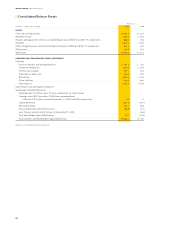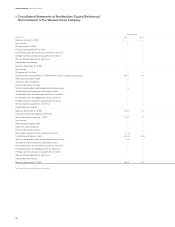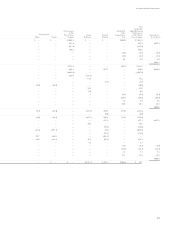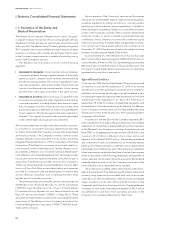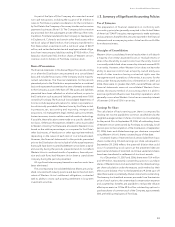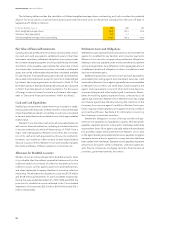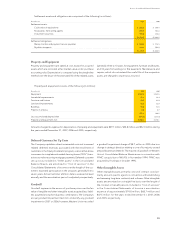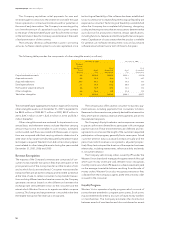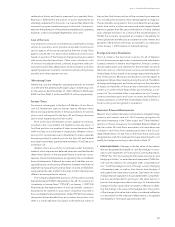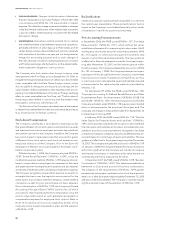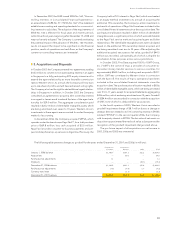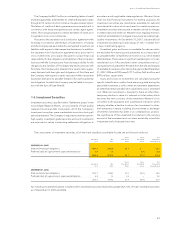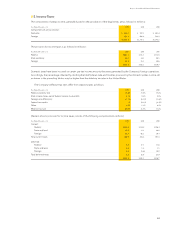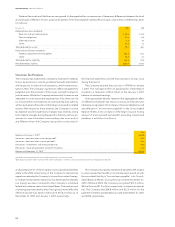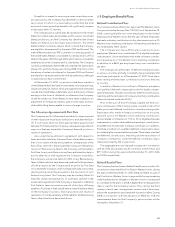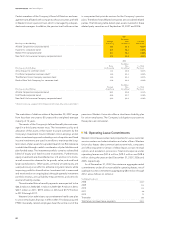Western Union 2007 Annual Report Download - page 60
Download and view the complete annual report
Please find page 60 of the 2007 Western Union annual report below. You can navigate through the pages in the report by either clicking on the pages listed below, or by using the keyword search tool below to find specific information within the annual report.58
WESTERN UNION 2007 Annual Report
||
FAIR VALUE HEDGES —
Changes in the fair value of derivatives
that are designated as fair value hedges of fi xed rate debt
in accordance with SFAS No. 133 are recorded in interest
expense. The offsetting change in value attributable to changes
in the benchmark interest rate of the related debt instrument
is also recorded in interest expense consistent with the related
derivative’s change.
||
UNDESIGNATED —
Derivative contracts entered into to reduce
the variability related to (a) settlement assets and obligations,
generally with terms of a few days up to three weeks, and (b)
certain foreign currency denominated cash positions, generally
with maturities of less than one year, are not designated as
hedges for accounting purposes and, as such, changes in
their fair value are included in operating expenses consistent
with foreign exchange rate fl uctuations on the related settle-
ment assets and obligations or cash positions.
The Company also had certain other foreign currency swap
arrangements with First Data, prior to September 29, 2006, to
mitigate the foreign exchange impact on certain euro denominated
notes receivable with First Data. These foreign currency swaps
did not qualify for hedge accounting and, accordingly, the fair
value changes of these agreements were reported in the accom-
panying Consolidated Statements of Income as “Foreign exchange
effect on notes receivable from First Data, net.” The fair value of
these swaps were settled in cash along with the related notes
receivable in connection with the Spin-off.
The fair value of the Company’s derivative fi nancial instruments
is derived from standardized models that use market based inputs
(e.g., forward prices for foreign currency).
Stock-Based Compensation
The Company currently has a stock-based compensation plan
that grants Western Union stock options, restricted stock awards
and restricted stock units to employees and other key individuals
who perform services for the Company. In addition, the Company
has a stock-based compensation plan that provides for grants
of Western Union stock options and stock unit awards to non-
employee directors of the Company. Prior to the Spin-off,
employees of Western Union participated in First Data’s stock-
based compensation plans.
Effective January 1, 2006, the Company adopted SFAS No.
123R, “Share-Based Payment” (“SFAS No. 123R”), using the
modifi ed prospective method. SFAS No. 123R requires all stock-
based compensation to employees be measured at fair value
and expensed over the requisite service period and also requires
an estimate of forfeitures when calculating compensation expense.
The Company recognizes compensation expense on awards on
a straight-line basis over the requisite service period for the
entire award. In accordance with the Company’s chosen method
of adoption, results for prior periods have not been adjusted.
Prior to the adoption of SFAS No. 123R, the Company followed
Accounting Principles Board (“APB”) Opinion No. 25 which
accounts for share-based payments to employees using the
intrinsic value method and, as such, generally recognized no
compensation expense for employee stock options. Refer to
Note 14 for additional discussion regarding details of the
Company’s stock-based compensation plans and the adoption
of SFAS No. 123R.
Reclassifi cations
Certain prior year amounts have been reclassifi ed to conform to
the current year presentation. These reclassifi cations had no
impact on the Company’s consolidated fi nancial position, results
of operations or cash fl ows as previously reported.
New Accounting Pronouncements
In September 2006, the FASB issued SFAS No. 157, “Fair Value
Measurements” (“SFAS No. 157”), which defines fair value,
establishes a framework for measuring fair value under GAAP
and expands disclosures about fair value measurements. SFAS
No. 157 applies to other accounting pronouncements that
require or permit fair value measurements. The new guidance
is effective for fi nancial statements issued for fi scal years begin-
ning after November 15, 2007, and for interim periods within
those fi scal years. The Company adopted the provisions of SFAS
No. 157 on January 1, 2008. The Company believes the impact
of adoption will not be signifi cant to the Company’s consolidated
fi nancial position, results of operations and cash fl ows as it has,
in most cases, historically reported assets and liabilities required
to be reported at fair value using the methods prescribed by
SFAS No. 157.
On September 29, 2006, the FASB issued SFAS No. 158,
“Employers Accounting for Defi ned Benefi t Pension and Other
Postretirement Plans — An Amendment of SFAS No. 87, 88, 106
and 132(R)” (“SFAS No. 158”). The remaining provisions that the
Company will adopt under SFAS No. 158 require a plan’s funded
status to be measured at the employer’s fi scal year end. The
Company will change its measurement date from September 30
to December 31 during 2008.
In February 2007, the FASB issued SFAS No. 159, “The Fair
Value Option for Financial Assets and Liabilities” (“SFAS No.
159”), which provides companies with an option to report selected
fi nancial assets and liabilities at fair value, and establishes pre-
sentation and disclosure requirements designed to facilitate
comparisons between companies that choose different measure-
ment attributes for similar types of assets and liabilities. The new
guidance is effective for fi scal years beginning after November
15, 2007. The Company adopted the provisions of SFAS No. 159
on January 1, 2008. The Company believes the impact of adoption
will not be signifi cant as the Company will not elect to measure
any fi nancial instruments or other items at fair value that are not
currently required to be measured at fair value.
In December 2007, the FASB issued SFAS No. 141R, “Business
Combinations” (“SFAS No. 141R”). This statement establishes a
framework to disclose and account for business combinations.
The adoption of the requirements of SFAS No. 141R applies
prospectively to business combinations for which the acquisition
date is on or after fi scal years beginning after December 15, 2008
and may not be early adopted. The Company is currently evaluat-
ing the potential impact of the adoption of SFAS No. 141R.


